Related Research Articles
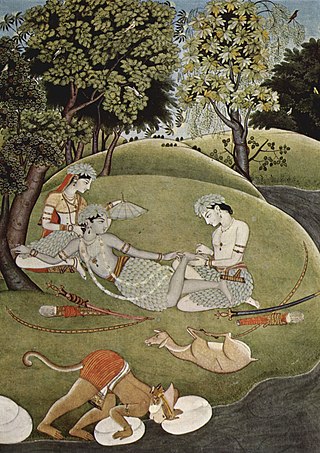
The Rāmāyana is a Sanskrit epic composed over a period of nearly a thousand years, with scholars' estimates for the earliest stage of the text ranging from the 2nd BC to 1st centuries AD, and later stages extending up to the 2nd century AD. Ramayana is one of the two important epics of Hinduism, the other being the Mahābhārata.

Seamus Justin Heaney was an Irish poet, playwright and translator. He received the 1995 Nobel Prize in Literature. Among his best-known works is Death of a Naturalist (1966), his first major published volume. Heaney was and is still recognised as one of the principal contributors to poetry in Ireland during his lifetime. American poet Robert Lowell described him as "the most important Irish poet since Yeats", and many others, including the academic John Sutherland, have said that he was "the greatest poet of our age". Robert Pinsky has stated that "with his wonderful gift of eye and ear Heaney has the gift of the story-teller." Upon his death in 2013, The Independent described him as "probably the best-known poet in the world".

Phra Sunthorn Vohara (Phu), known as Sunthorn Phu, is Thailand's best-known royal poet. He wrote during the Rattanakosin period.
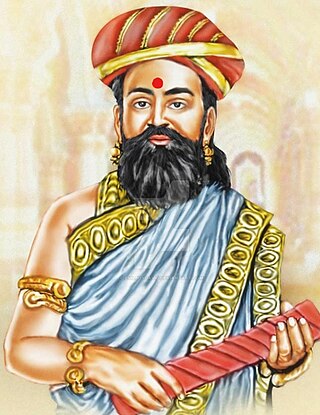
Kambar or Kavichakravarthy Kamban was an Indian Tamil poet and the author of the Ramavataram, popularly known as Kambaramayanam, the Tamil version of the epic Ramayana. Kambar also authored other literary works in Tamil, such as Thirukkai Vazhakkam, Erezhupathu, Silaiyezhupathu, Kangai Puranam, Sadagopar Anthathi and Saraswati Anthathi.

Sachchidananda Hirananda Vatsyayan, popularly known by his pen name Agyeya, was an Indian writer, poet, novelist, literary critic, journalist, translator and revolutionary in Hindi language. He pioneered modern trends in Hindi poetry, as well as in fiction, criticism and journalism. He is regarded as the pioneer of the Prayogavaad (experimentalism) movement in modern Hindi literature.
Tenali Ramakrishna ( Telugu: తెనాలి రామకృష్ణ కవి / తెనాలి రామలింగడు/ తెనాలి రామకృష్ణుడు )was an Indian poet, scholar, thinker and a special advisor in the court of the Vijayanagar king Krishnadevaraya, who ruled from C.E. 1509 to 1529. He was a Telugu poet who hailed from a village called Tenali located at what is now the Andhra Pradesh region, generally known for the folk tales which focus on his wit. He was one of the Ashtadiggajas or the eight poets at the court of Krishnadevaraya.

Kaifi Azmi was an Indian Urdu poet. He is remembered as the one who brought Urdu literature to Indian motion pictures. Together with Pirzada Qasim, Jaun Elia and others he participated in many memorable Mushaira gatherings of the twentieth century. His wife was theatre and film actress Shaukat Kaifi.
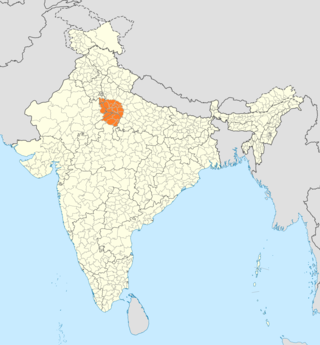
The Braj language, Braj Bhasha, also known as Vraj Bhasha or Vrij Bhasha or Braj Bhāṣā or Braji or Brij Bhasha or Braj Boli, is a Western Hindi language. Along with Awadhi, it was one of the two predominant literary languages of North-Central India before the switch to Hindustani in the 19th century.

Shri Sant Namdev Maharaj, also transliterated as Nam Dayv, Namdeo, Namadeva, was a Marathi Vaishnav saint from Narsi, Hingoli, Maharashtra, India within the Varkari tradition of Hinduism. He lived as a devotee of Lord Vitthal of Pandharpur. He is widely regarded as the founder of Varkari tradition.

Swami Rama Tirthapronunciation (help·info), also known as Ram Soami, was an Indian teacher of the Hindu philosophy of Vedanta. He was among the first notable teachers of Hinduism to lecture in the United States, travelling there in 1902, preceded by Swami Vivekananda in 1893 and followed by Paramahansa Yogananda in 1920. During his American tours Swami Rama Tirtha spoke frequently on the concept of 'practical Vedanta' and education of Indian youth. He proposed bringing young Indians to American universities and helped establish scholarships for Indian students.
Govind Vinayak Karandikar, better known as Vindā, was an Indian poet, writer, literary critic, and translator in the Marathi-language.
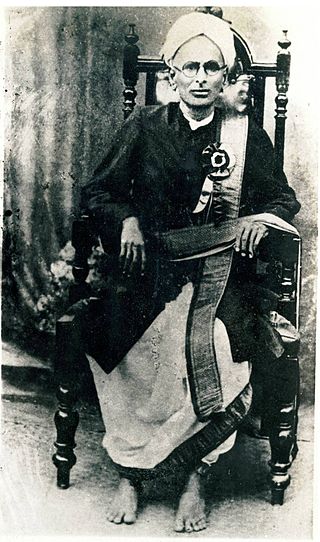
The Bhasha Kavisekhara Mahavidwan R. Raghava Iyengar (1870–1946) was known for critical scholarship and creative interpretation of literature.
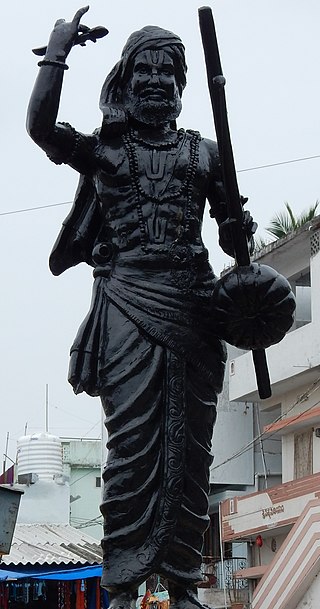
Kancharla Gopanna, popularly known as Bhakta Ramadasu or Bhadrachala Ramadasu, was a 17th-century devotee of the Hindu god Rama, a saint-poet and a composer of Carnatic music. He is a famous Vaggeyakara from the Telugu classical era. He was born in the village of Nelakondapalli in Khammam district, and orphaned as a teenager. He spent his later years in Bhadrachalam and 12 years in solitary confinement at the Golconda prison during the Qutb Shahi-rule. Different mythical stories about his life circulate in the Telugu tradition. He is renowned for constructing the famous Sita Ramachandraswamy Temple and pilgrimage center on the banks of river Godavari at Bhadrachalam. His devotional kirtana lyrics to Rama illustrate the classical Pallavi, Anupallavi and Caranam genre composed mostly in Telugu, some in Sanskrit and with occasional use of Tamil language. These are famous in South Indian classical music as Ramadaasu Keertanalu.
Ramapuram is a town in the Kottayam district of the Indian state of Kerala.

Ravidas or Raidas was an Indian mystic poet-saint of the Bhakti movement during the 15th to 16th century CE. Venerated as a guru (teacher) in the modern regions of Uttar Pradesh, Bihar, Rajasthan, Gujarat, Maharashtra, Madhya Pradesh, Punjab, and Haryana, he was a poet, social reformer and spiritual figure.
Modern Kannada literature refers to the body of literature written in the Kannada language, a language spoken mainly in the Indian state of Karnataka. The Kannada script is the writing system used in Kannada literature. In the last forty years, eight modern Kannada authors have been awarded the Jnanpith award, a prestigious private literary award in India. In addition, the Sahitya Akademi Award, the second-highest award for literature granted by the Government of India, has been conferred upon Kannada writers fifty times.

Vijayanagara literature in Kannada is the body of literature composed in the Kannada language of South India during the ascendancy of the Vijayanagara Empire which lasted from the 14th through the 16th century. The Vijayanagara empire was established in 1336 by Harihara I and his brother Bukka Raya I. Although it lasted until 1664, its power declined after a major military defeat by the Shahi Sultanates in the battle of Talikota in 1565. The empire is named after its capital city Vijayanagara, whose ruins surround modern Hampi, now a World Heritage Site in Karnataka.

Kerala Varma, most commonly known as Mahakavi Pandalam Kerala Varma, was an Indian poet, scholar, and publisher. He was born in Pandalam, and belonged to the Pandalam Royal Family. He wrote two mahakavyas, more than a hundred narrative poems, translations, and children's poetry. He is widely regarded as the author of the first complete mahakavya in Malayalam. He was the owner and Chief Editor of Kavana Kaumudi, the first Malayalam periodical, which was also the first to introduce special issues in Malayalam.

Rajanikanta Sen, also known as Kantakobi, was a Bengali poet and composer, known for his devotional (bhakti) compositions, as well as his patriotic songs.
Kalim Aajiz was an Indian writer of Urdu literature and a poet. He was an academic and chairman of the Urdu Advisory Committee of the Government of Bihar. He was a recipient of the fourth highest Indian civilian honour of Padma Shri from the Government of India in 1989.
References
- ↑ Amaresh Datta. The Encyclopaedia of Indian literature (Volume One (A To Devo), Volume 1. Sahitya Akademi.